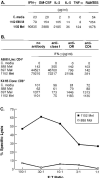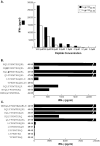Identification of a MHC class II-restricted human gp100 epitope using DR4-IE transgenic mice
- PMID: 10725708
- PMCID: PMC2241739
- DOI: 10.4049/jimmunol.164.7.3535
Identification of a MHC class II-restricted human gp100 epitope using DR4-IE transgenic mice
Abstract
CD4+ T cells play a central role in the induction and persistence of CD8+ T cells in several models of autoimmune and infectious disease. To improve the efficacy of a synthetic peptide vaccine based on the self-Ag, gp100, we sought to provide Ag-specific T cell help. To identify a gp100 epitope restricted by the MHC class II allele with the highest prevalence in patients with malignant melanoma (HLA-DRB1*0401), we immunized mice transgenic for a chimeric human-mouse class II molecule (DR4-IE) with recombinant human gp100 protein. We then searched for the induction of CD4+ T cell reactivity using candidate epitopes predicted to bind to DRB1*0401 by a computer-assisted algorithm. Of the 21 peptides forecasted to bind most avidly, murine CD4+ T cells recognized the epitope (human gp10044-59, WNRQLYPEWTEAQRLD) that was predicted to bind best. Interestingly, the mouse helper T cells also recognized human melanoma cells expressing DRB1*0401. To evaluate whether human CD4+ T cells could be generated from the peripheral blood of patients with melanoma, we used the synthetic peptide h-gp10044-59 to sensitize lymphocytes ex vivo. Resultant human CD4+ T cells specifically recognized melanoma, as measured by tumor cytolysis and the specific release of cytokines and chemokines. HLA class II transgenic mice may be useful in the identification of helper epitopes derived from Ags of potentially great clinical utility.
Figures




References
-
- Boon T, Coulie PG, Van den Eynde B. Tumor antigens recognized by T cells. Immunol. Today. 1997;18:267. - PubMed
-
- Marchand M, van Baren N, Weynants P, Brichard V, Dreno B, Tessier MH, Rankin E, Parmiani G, Arienti F, Humblet Y, et al. Tumor regressions observed in patients with metastatic melanoma treated with an antigenic peptide encoded by gene MAGE-3 and presented by HLA- A1. Int. J. Cancer. 1999;80:219. - PubMed
-
- Nestle FO, Alijagic S, Gilliet M, Sun Y, Grabbe S, Dummer R, Burg G, Schadendorf D. Vaccination of melanoma patients with peptide- or tumor lysate-pulsed dendritic cells. Nat. Med. 1998;4:328. - PubMed
MeSH terms
Substances
Grants and funding
LinkOut - more resources
Full Text Sources
Other Literature Sources
Research Materials

